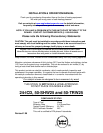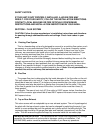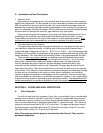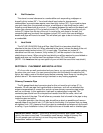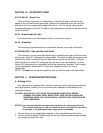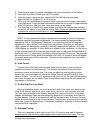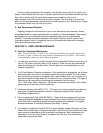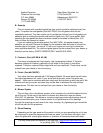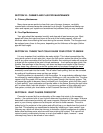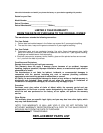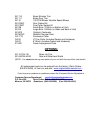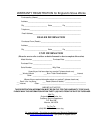
SECTION VII: CHIMNEY AND FLUE PIPE MAINTENANCE
A. Chimney Maintenance
Many stove owners prefer to clean their own chimneys; however, we highly
recommend a chimney sweep be contacted to do this job. A professional sweep can
clean and inspect your system and sometimes find problems that you may overlook.
B. Flue Pipe Maintenance
Your pipe should be inspected monthly and cleaned at least once per year. Most
people will clean their pipe and stove at the end of the heating season, which will
eliminate odors from entering the house during the summer months. The flue pipe must
be replaced every three to five years, depending on the thickness of the pipe (thicker
pipe will last longer).
SECTION VIII: THINGS THAT COULD CAUSE YOUR STOVE TO SMOKE
It is very important that installation be made airtight. This is best accomplished by
using stove cement at each pipe joint, where the first section enters the stove flue collar
and at any other connection such as the flue thimble. Any existing air leaks will cause air
to draw into the system at the point of least resistance -- such areas are pipe joints, flue
thimble, flue openings in the chimney, ash clean-out doors and cracks in the chimney.
These areas may cause air to enter the system and not be drawn through the stove,
which could result in a cool chimney, causing the smoke to build up in the flue and
eventually come back into the house. This is called “back puffing” and can be corrected
by sealing all troublesome areas so they are airtight.
Another problem is a downdraft in the flue system. Air currents being deflected down
the chimney by nearby objects such as trees, buildings or a hill can cause this. The other
cause is that flue gases chill too quickly as they pass through the chimney system. This
will cause the gases to become heavy and back up in the system, which will often result
in “back puffing,” poor combustion and smoke odors in the house. Burning the unit hotter
will, in some cases, help this situation. If you have any problem of this nature with your
flue system, contact your local dealer or call Customer Service at (800) 245-6489.
SECTION IX: WHAT CAUSES CREOSOTE?
Creosote is caused by the condensation of the vapor that exists in the escaping
smoke -- the moisture level of your fuel will determine the density of this vapor. A severe
downdraft as discussed previously will cause creosote. Moisture will form at the coolest
point in your chimney system and at this point will tend to build creosote. The ash is
picked up by the moisture in the system and will build up or run back down the inside of
your flue. This situation can sometimes be helped by installing an “open vented” type
chimney cap, which will allow the chimney to maintain a higher temperature to create a
better draw and keep some wind currents from entering the system. This cap will not
correct a poorly constructed chimney or one in bad need of repair, however -- some
chimneys may have to be relined or even rebuilt.



